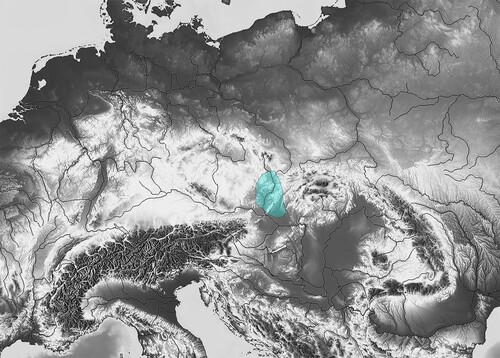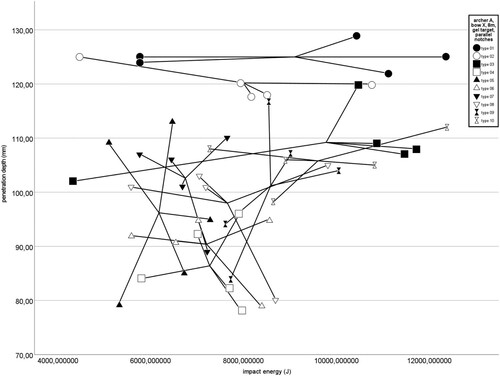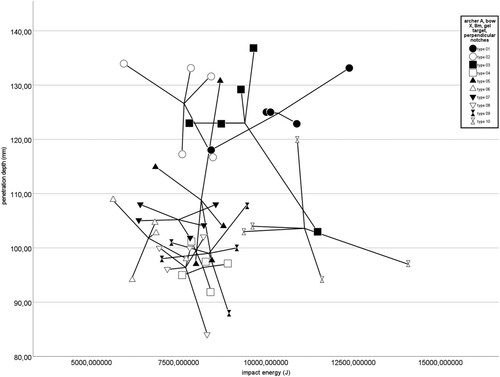 ?Mathematical formulae have been encoded as MathML and are displayed in this HTML version using MathJax in order to improve their display. Uncheck the box to turn MathJax off. This feature requires Javascript. Click on a formula to zoom.
?Mathematical formulae have been encoded as MathML and are displayed in this HTML version using MathJax in order to improve their display. Uncheck the box to turn MathJax off. This feature requires Javascript. Click on a formula to zoom.ABSTRACT
Lithic archery projectiles during the short timespan at the end of the Eneolithic period and the beginning of the Bronze Age in Europe have alternately been deemed hunting implements, weapons, or symbolic artefacts. More than 400 projectiles of this period have been analysed in 3D metrics. All but a few are triangular barbed projectiles. Despite differences in size and weight, four types of arrowheads have been identified using 3D shape alone. Experiments to clarify their ballistic behaviour, based on weight, Tip Cross-Sectional Area (TCSA), differences in the shaping of their tips, the height of the cross-section, and cross-sectional asymmetry in distribution of mass were carried out. The 3D data on the projectiles, their wound cavities, and their measured initial and impact velocities were used to verify functional differences and the potential wounding impact.
HIGHLIGHTS
Ballistic properties of projectiles from Early Bronze Age were experimentally tested.
Arrowheads that caused perpendicular fissures or rotated after the contact were identified.
A total of 260 shots were used in various experimental tasks.
Introduction
Accurate knowledge of the lethality and wounding capability of lithic projectiles is an important precondition for the correct archaeological interpretation of their use and hence of the societies in which they were used.
The known wounding impact involves penetration, with the perforation of vitals, the release or fragmentation of the arrowhead into body tissues (Cheshier & Kelly, Citation2006; Titmus & Woods, Citation1986), poisoning (Foster, Citation2020; Lemorini & Cocca, Citation2013; Lombard, Citation2020), infection (Milner, Citation2005), and radial fissures and rotation. The impact also needs to penetrate a natural or artificial body covering. All these strategies can be applied for various purposes in archery, and differ according to context; whether the intended victim is animal or human (Loendorf et al., Citation2015), what hunting strategyis used (Coppe & Rots, Citation2017; Tomasso et al., Citation2018; Yaroshevich et al., Citation2010), the size of the game (Buchanan et al., Citation2011; Wood & Fitzhugh, Citation2018), and the region.
Traditionally, the depth of penetration and fragmentation have been the focus of archaeological ballistic experiments, especially comparisons of projectiles of various types and sizes (Anderson, Citation2010; Karger et al., Citation1998; Waguespack et al., Citation2009). The relationship of inverse proportionality between the tip cross-sectional area (TCSA) and the depth of penetration has been tested several times (Mika et al., Citation2020; Sitton et al., Citation2020). The relevant studies have used symmetric projectiles of similar shapes that usually differ only in their 2D contours or length (Eren et al., Citation2020). Such differences can be important from an archaeological perspective, but play a negligible role in the ballistic action of the projectile. The only ballistic consequence of a difference in length is a difference in weight, and the length is not, in itself, a ballistic parameter. The ballistic influence of the 2D contours of the projectile is related only to the projectile’s maximal width, i.e. the wound width (Nosek & Kaňáková, Citation2021). Although asymmetrical lithic projectiles have been used in experiments on archery (Salem & Churchill, Citation2016), the impact of asymmetries on the ballistic profile of the projectile, its rotational tendency and wounding capability have not been evaluated. The authors mention that the wound volume of such projectiles is 7.6% higher than the wound of symmetric projectiles (Salem & Churchill, Citation2016, p. 207), reconstructing the values of wound volume as a product of TCSA and attained depth of penetration, as has, to date, been usual (Wood & Fitzhugh, Citation2018). The wound volume has also been measured as the 2D area of a gelatine target section (Wilkins et al., Citation2014). This method has shown that both the permanent and the temporary wound channels are measurable areas (Schyma, Citation2010; Schyma, Citation2020). Some authors (Wood & Fitzhugh, Citation2018; Salem & Churchill, Citation2016, p. 206; Wilkins et al., Citation2014, p. 3; Anderson, Citation2010) have claimed that a proper wound relates only to a permanent cavity, whereas the area or volume of a temporary cavity is considered negligibly small due to the assumed elasticity of the tissue. This probably holds true in the case of untipped or narrow-stemmed symmetric projectiles, the kinetic energy of which is exhausted mainly by deep penetration and which cause a narrow wound channel. However, at the velocities attained, penetration of 10–15 cm developed in one-hundredth of the second. Such rapid performance significantly limits the ability of tissues to accommodate, especially in the case of wider, thicker or rotating projectiles. Some shape-related properties – barbs, cross-sectional asymmetry, and the height of the cross-section – can significantly increase the volume of the temporary channel. This limits the chances of surviving a shot as it significantly reduces healing capability, and increases the risk of infection and secondary necrosis (Dougherty et al., Citation2009, p. 133; Alexandropoulou & Panagiotopoulos, Citation2009, p. 31). In periods involving the nearly exclusive use of such projectiles, the volume of tissue damaged by radial fissures, as well as the haematoma of lacerated or incised tissues, capillaries, and nerves, is an important parameter of use in assessing the archer’s role in society, especially if evidence of hunting of wild fauna is scarce and isolated (Bátora, Citation1991; Kyselý, Citation2012; Roblíčková, Citation2003).
The ballistic properties of lithic arrowheads include their weight, TCSA, impact velocity, 3D shape of the tip, and cross-sectional asymmetry. The ballistic properties of bows, shafts, and the archer’s physical attributes are not usually available for archaeologists studying the eastern part of Central Europe owing to a lack of preservation of organic remains and poor preservation of skeletons in the studied periods (Chochol, Citation1970; Stloukal, Citation1985; Šefčáková, Citation2014).
A systematic analysis of projectiles of the Nitra culture from the Early Bronze Age began in 2015 (). In an analysis of roughly 300 projectiles from the Nitra culture (Kaňáková et al., Citation2016; Kaňáková et al., Citation2019; Kaňáková et al., Citation2020), an intentional design feature was identified in the shape of cross-sectionally asymmetric archery projectiles (Kaňáková, Citation2020c). This prominent asymmetry in the cross-sectional mass distribution affects the terminal ballistics of such projectiles. Its influence on external ballistics has been tested for dart projectiles, both in the context of natural shooting (Lipo et al., Citation2012) and in a wind tunnel (Pettigrew et al., Citation2015). Archery projectiles are significantly lighter than dart projectiles, and a measurable influence on flight trajectory is seen as improbable, or possible only under the influence of an external spin impulse. A total of 291 projectiles from the Nitra culture were analysed: Of them, 72% were asymmetric in cross-section, 14% were screw-shaped, with a pronounced torsion of both lateral edges, 23% had deviating barbs, and 18% of these had barbs deviating in opposition. Possible ballistic features, in addition to cross-sectional asymmetry, have also been identified. Although most arrowheads had a flat tip, 26% of them had a heavy tip with a rhombic cross-section. Although a majority of the Nitra projectiles had a flat body, 23.5% of them had a high cross-section. The arrowheads varied widely in size, partly owing to the common practice of rejuvenating the projectiles after tip fracture (Kaňáková, Citation2020b). All research data, including high-precision 3D models and filterable metadata, are available in the Digitalia Projectiles open-access dataset (projectiles.phil.muni.cz). More information on the Nitra culture is available in the Supplementary Information.
We carried out a ballistic experiment in this study to test projectile behavior in terms of wounding for a wide range of tasks. Because of differences in the raw materials, shape, hafting area, and weight, the results from most of the relevant experiments are not applicable to the Early Bronze Age projectiles from Central Europe. The projectiles tested in recent studies were heavier, and their hafting was based on the stem or the neck (Charlin & Gonzales-José, Citation2012). Arrowheads in the studied period and region were barbed, i.e. their mass points were different, and were not stabilized by a heavy longitudinal axis of the stem. Their ballistic behavior was distinct. The impact fragmentation was slight, limited to the tip or barb of the arrowhead, due to the resistance of the raw materials. Shattering has not been identified in the studied period and region (Kaňáková, Citation2020a, pp. 99–106). All arrowheads found stuck in the bone of buried skeletons of the Nitra culture were almost complete, not one was shattered (Bátora, Citation2018, pp. 303–304). No tradition of poisoning has been noted. Users of poison tend to favor organic projectiles as porous materials can better preserve the poison for longer (Lombard, Citation2020; Foster, Citation2020, p. 84). In the case of lithic arrowheads, poisoning is usually mentioned, hypothetically, as a means of improving the effectiveness of arrowheads supposed to be low efficient (Lemorini & Cocca, Citation2013), which is not the case for Nitra projectiles. Based on this scenario, we focus, in the context of wounding analysis, on the development of the wound channel, and on identifying the specific impact of wounding due to rotation or by radial fissures, which correlate with the specific morphological features of the analysed projectiles from the Nitra culture.
Materials and methods
Our experimental testing of the ballistic behavior of lithic projectiles from the Early Bronze Age was based on a comparison of 10 ballistic types of projectiles. Due to specifics of the 3D shape of arrowheads from the Nitra culture, we aimed for the highest precision in copying their shape and proportions. This was not attainable by knapping, which can be used to simulate the concept but not the precise shape. Because weight is a well-known ballistic parameter whereas shape is not, we preferred precise copies of the shape to precise copies of the weight of the projectile. Fragmentation testing was excluded because of the light fragmentation and lack of shattering documented for the original collection. The individual original projectiles were copied (). We used epoxy casts with the maximum ratio of sand filling of 100:180. Although the casts were slightly lighter than the actual projectiles, the absolute difference in weight was negligibly small because the original projectiles were very light in the first place (). The differences in weight ranged from 0.15 to 1.13 g, which in terms of impact energy with a velocity of 30 m/s led to a minor change, from 0.0675 to 0.5085 J. Additional testing with approximate lithic knapped copies was performed to examine the difference caused by this negligible deviation in weight. The shafts, gluing, and the binding method were standardized. The spruce shafts were 29 in. long, 5/16 inch in diameter, and had a spine (toughness) for 35 to 40 lbs. The fletching was standardized with three fins attached straight to the shaft. The shafts weighed 15 g, with a tolerance to deviation of 2 g. Heavier woods were tested for the shafts, closer to the supposed species of the original shafts, but the requisite balance and stabilization were not attained during training for shooting. All details of the arrows and target preparation are provided in the Supplementary Information.
Figure 2. Original artefacts, prototypes of ballistic types 01–10; cross-sections and longitudinal profile based on precise 3D documentation layouts.
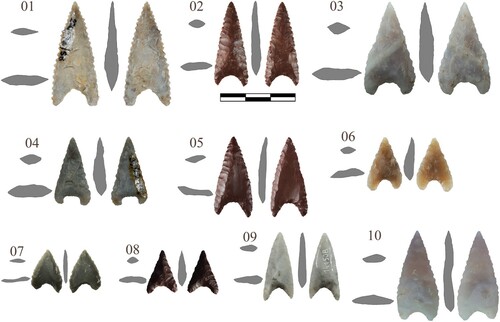
Table 1. Overview of ballistic types tested.
Although many ballistic experiments use machine projection, we incorporated a human archer as a variable into the experiment. The performance of the human archer is not stringently standardized. However, it allows us to better describe the projectile possibilities, limits and specifics closer to their authentic acting. The experiment involved two bows and two archers, combined in strictly separated tasks, to test how distinct draw weights, draw lengths, and shooting styles influenced the ballistic values. The bow marked as “X” had a fibreglass–wood construction and a draw weight of 35 lbs. The maximal and median draw lengths for archer A were 60 and 58.2 cm, and for archer B were 64.5 and 62.1 cm, respectively. This bow was used for all shots within the basic statistics (gel, gel with overlay, and clay). The bow marked as “Y” was built from ash wood, and had a maximum draw weight of 55 lbs. The maximal and median draw lengths for archer A were 58 and 55.9 cm, and for archer B were 62.4 and 59.5 cm, respectively. This bow was used for secondary purposes to test projectile behavior. It was clear after several training shots that bow Y was close to the upper limit for use with such light projectiles. Although splitting the experiment into various tasks reduced the sizes of the datasets, it allowed us to describe the performance of the projectiles over a wide spectrum of conditions. It was important to test whether the projectiles perform similarly when used by distinct archers and in different bows, i.e. if the observed features were typical for such projectiles or the differences in performance were related to individual archery style. The shooting range was located in a wooden hall, protected from the wind and other impacts of weather.
A set of high-speed cameras were used to measure the starting and impact velocities. The median starting velocities of the two bows were similar, at 41.72 m/s (bow X) and 41.56 m/s (bow Y). The details have been provided in the Supplementary Information (Table SI 5). The impact velocity was measured over 8 m; in the secondary tasks, it was also tested at distances of 10 and 14 m.
Gel and clay targets were used to document the terminal trajectory in order that the distinct features could be observed. The gel enabled measurement of the wounding cavities and observations of the radial fissures, whereas the clay allowed us to observe the rotational features of the projectile. Hit targets were documented in several steps by using photography and 3D photogrammetry. The process of documentation used for gel targets included contra-jour lighting in three phases: with the arrow intact in the wound, the empty wound cavity, and the wound cavity filled with a contrasting liquid medium. This revealed how extensive the wound tract was, including the perpendicular fissures and arc-shaped traces (Supplementary Information, Fig. SI 6). The gel block was then carefully divided into two along the axis of impact and these parts were further documented. The digitally read areas of the permanent and temporary cavities were compared in each half.
The volumes of the cavities were calculated using the following formula:
where we replace the variables with the area of the permanent or the temporary cavity (A) read out digitally from photographs at the measured depth of penetration (d).
The above equation is based on the relationship between the formulae for calculating the volume of a cylinder and its vertical cross-sectional area, where the height of the cylinder is the depth of penetration:
and
Because the radius of the wound cavity varies and does not exhibit any regular geometric shape, we use this simple mathematical operation to eliminate the radius from the formula and replace it with the vertical cross-sectional area of the object.
The lifespan of the casting matrix was limited to 25 copies, i.e. we disposed of a set of 250 projectiles. Twenty-two copies of every ballistic type were used in the experiment and three copies were used for training. We tried to balance the number of tasks and the size of the datasets to be able adequately validate the measured values. In the experiment, 10 copies of every ballistic type were shot at the gel targets (archer A, bow X, 8 m distance). Half of them had parallel slots (the front slot for projectile insertion and the end slot for the bow-string) and the other half had perpendicular slots. This helped clarify the conditions of rotation of the barbed projectiles with cross-sectional asymmetry with and without an additional spin impulse. The other three copies were shot at clay targets, and six copies were shot at gel targets with overlays: a linen canvas, tanned leather, and light gambeson. The last three copies were used in secondary tasks to calculate differences in the impact velocity between the archers and bows at various distances.
The tip cross-sectional area (TCSA) influences the depth of penetration. Experiments on cross-sectionally symmetric projectiles with similar 3D shapes (usually slight differences in 2D contours or length) have shown that the higher the TCSA is, the lower is the depth of penetration (Sitton et al., Citation2020). Where the 3D shapes differ, this dependence is disrupted because the shape influences the penetration of the tissue by the projectile. Because projectiles from the Nitra culture are barbed, and their cross-section is asymmetric and variable along the longitudinal axis, the TCSA does not reflect the actual area of entry of the projectile into the body. We thus used the total cross-sectional area (ToCSA), the projection of all cross-sections along this axis (Nosek & Kaňáková, Citation2021).
The measured values of the terminal ballistic parameters were plotted by using IBM SPSS Statistics 27 software. The mid-pivot method was used to test smaller sets of data (Horn, Citation1983).
Results
The first parameter pertaining to the resulting wound was the impact energy, which was based on the impact velocity and weight of the projectile. Higher values of it were achieved with large, i.e. heavy projectiles – ballistic types 01, 03, and 10 – whereas lower values were observed for light projectiles – small projectiles of ballistic types 06 to 08 as well as the very light, flat, torsional projectile type 05 (). In accordance with previous experimental results for dart projectiles (Lipo et al., Citation2012; Pettigrew et al., Citation2015), we observed that light arrows weighing from 15 to 20 g did not have sufficient potential to convert the spin effect of the cross-sectional asymmetry into actual rotation in external ballistics, i.e. during the flight. The use of shafts with the perpendicular position of the front and end slots provided a starting spin impulse that reduced the starting vibration of the shaft end. Better stabilization of the arrow reduced the loss of velocity as well as the wide variation in impact energy (). This effect was most evident with ballistic type 05, which had a screw-like design with a flat projectile body, whereas it was rather insignificant or non-existent with small (ballistic types 06 to 08) or narrow (ballistic types 02 and 09) projectiles, regardless of their cross-sectional symmetry or asymmetry.
Figure 3. Impact velocity differences of arrows with parallel and perpendicular notches in absolute values and using a t-test.
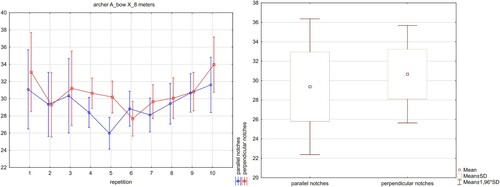
Table 2. Impact velocity and contact energy of ten ballistic types of projectiles.
The difference in velocity between arrows of the same ballistic type, but with parallel and perpendicular slots, proved to be statistically significant. The p-value of the t-test was lower than 0.05. The use of perpendicular notches can naturally be only hypothetical because the original shafts were not preserved. Nevertheless, this ballistic test helped clarify the effects of the individual variants of shooting and arrow design. We also proved that shape and asymmetry influenced the external ballistics if an additional spin impulse was given, such as through use of perpendicular notches or helical fletching. Asymmetric and mainly rotationally asymmetric projectiles (screw shaped) responded well to stabilizing improvements in the arrows because they had a higher tendency to rotate.
The impact energy (weight and velocity) directly influences the development of the wound channel. Nevertheless, other aspects affect this process as well. The depth of penetration increased with the impact energy for arrowheads of similar 3D shape, which varied only in weight. The 10 ballistic types tested were clearly clustered when this relationship was plotted (). Large, mainly symmetric projectiles (01, 02, 03, and 10) created horizontal clusters, i.e. although their impact energy varied, their performance in terms of depth of penetration was the same. The range of values was wider still for type 03, which was not cross-sectionally symmetric; nevertheless, its high cross-section probably partly balanced this asymmetry. Except for the one anomalous value, type 08, symmetric but small, showed a similar horizontal pattern. Highly cross-sectionally asymmetric projectiles (05, 09, and less conspicuously, the lighter type 07) exhibited vertical patterns, i.e. they reached a stable impact energy but their depth of penetration oscillated. This was influenced by another factor: post-contact rotation. The last group, tiny arrowheads with a high cross-section, i.e. with the mass point at the central axis, exhibited a balanced pattern both horizontally and vertically. It was caused by two aspects. They were light – they had low impact energy, and their high cross-section induced higher tissue resistance. They reached only a shallow depth of penetration and; moreover, projectiles in both groups had rhombic tips, i.e. a part of their kinetic energy was exhausted already during contact.
If the arrows were stabilized by the additional spin impulse of perpendicular slots (), their horizontal range significantly narrowed. The group of large, mainly symmetric projectiles attained the highest penetration. The longitudinally undulated type 10 was more isolated from the group than in case of no spin impulse. In the group of cross-sectionally asymmetric projectiles, the pattern did not change in terms of horizontal narrowness because it was narrow even without the spin impulse. However, the depth of penetration significantly increased, especially with larger projectiles (05, 09), and lesser conspicuously with lighter ones (07). Except for one anomalous value, their vertical range narrowed, and their performance was more standardized. The post-contact rotation would likely have begun more fluently and successfully if the projectile had obtained a spin already during flight. For the third group of small arrowheads with a high cross-section, the pattern narrowed both horizontally and vertically, and depth of penetration increased.
Arrowheads of all types responded to flight stabilization with an increase in the depth of penetration and a decrease in dispersion. This was most conspicuous in cross-sectionally asymmetric arrowheads.
We plotted the depth of penetration against the ToCSA for all ballistic types (). Cross-sectionally symmetric, flat arrowheads (01, 02) were found to be clustered above the curve of inverse proportionality, whereas all arrowheads with special shapes were clustered below it: both asymmetric (05, 07 and 09) arrowheads and those with a high cross-section (04, 06). The cross-sectionally symmetric specimens had a narrow vertical range and a high depth of penetration but middling values of ToCSA. The cross-sectionally asymmetric arrowheads had a significantly wider vertical range because their mechanism of post-contact rotation was irregular. Although types 07 and 09 had very low ToCSA values, they had low depths of penetration because they lost energy due to rotation. Moreover, arrowheads with a high cross-section had very low penetration with respect to their ToCSA because they lost the energy when creating radial fissures. The vertical range of their penetration was narrow because such performance is regular. The differences were easily observable in comparison with those of projectiles with similar values of ToCSA. Types 01 and 10 were large, cross-sectionally symmetric, and had similar values of ToCSA. The flat type 01 had greater penetration than the longitudinally undulated type 10. The longitudinal undulation probably had another wounding effect in the tissue that exhausted its energy. The specimens with the lowest ToCSA (07, 08, 09) did not penetrate deeply. Types 02, 05, and 06 had similar ToCSA; the symmetric type 02 was well above the curve, whereas the cross-sectionally asymmetric type 05 had a large dispersion in values, and approached the curve only marginally. The tiny, thick type 06 attained only low values, despite the fact, that type 06 had higher impact energy than type 05. Type 04, with a middling value of ToCSA, did not reach middling depths of penetration; its values were well below the curve. Types 04 and 06 did not have high ToCSA, but had a high cross-section and a rhombic tip, which made penetration more difficult because their energies were exhausted during contact.
Figure 6. Relation of the ToCSA of the projectile to the penetration depth of arrows with parallel notches.
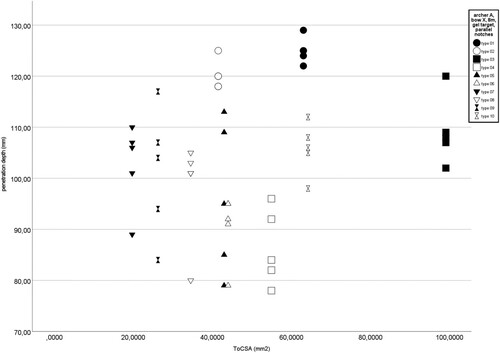
In shots with an additional spin impulse (), types 01, 02, and 03 stayed above the curve, and type 10 fell below it. Asymmetric or thick specimens stayed below the curve. This shows that such projectiles had exhausted their impact energy not only owing to direct penetration, but also due to other wounding effects.
Figure 7. Relation of the ToCSA of the projectile to the penetration depth of arrows with perpendicular notches.
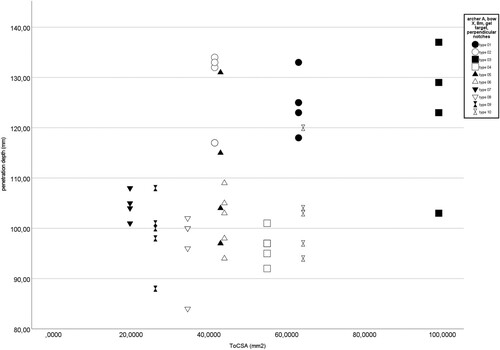
In addition to correlations among the ToCSA, impact energy, and depth of penetration, the wounding effect was well exemplified in the development of the permanent and temporal wound channels. We plotted the ToCSA against the volumes of both channels ( and ). The benefits of the deep penetration attained by specimens of types 01, 02, and 03 were not manifested in their wounding capability, except in one anomalous value for the temporary cavity for type 01. Direct, fluent penetration led to a direct and narrow wound channel, which had wounding potential only in terms of perforating the body vessels. Another large symmetric arrowhead type 10 (the undulated) reached lower penetration than types 01 and 02. Despite this, type 10 reached similar or higher wound volume, indicating a distinct wounding capability in the affected tissue.
Figure 8. Relation of the ToCSA of the projectile to the volume of its Permanent and Tempory wound channel. Arrows with parallel notches.
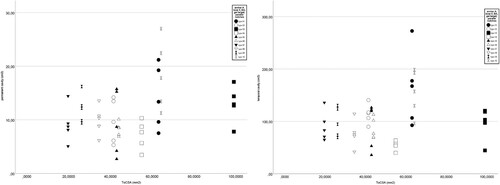
Figure 9. Relation of the ToCSA of the projectile to the volume of its Permanent and Tempory wound channel. Arrows with perpendicular notches.

In the case of arrowheads with special shapes, even the measurement of the volume of the wound, obtained by using the area of the longitudinal section of the target, could not reflect its entire wounding capability because we could not measure the area of the rotational arcs and radial fissures that have been documented (, ). The cross-sectionally asymmetric types 05, 07, and 09 reached volumes comparable with projectiles with significantly deeper penetration (type 01). This volume, nevertheless, needed to be multiplied by the area of rotation. Although types 05, 07, and 09 had distinct values of ToCSA, they all formed permanent and temporary cavities of similar volume. Two or three revolutions (a half-rotation visible as one arc in the section) were observed with all these types in an approximately 15-cm-long wound channel. In addition to the clay targets, arc-shaped traces reflecting the revolution of the projectile were sometimes visible in the gel targets. Although we do not yet know how many rotations would occur in the case of penetration into living tissues, we can estimate that they would slightly exceed those for clay targets, because the arcs were identified in gel too, which has approximately the same density as that of human soft tissue.
Figure 10. Above: Radial fissures in gel targets (projectile no.03_03). Below: Revolution arc-shaped traces in clay target. Arrows present features of projectile revolution (projectile no. 09_17).
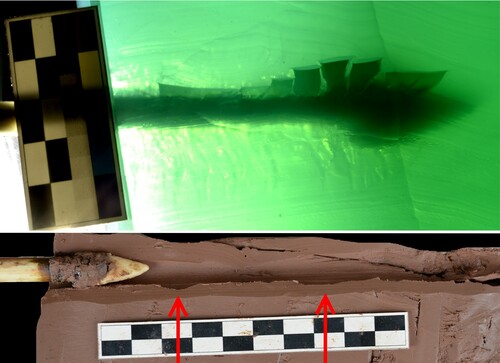
Table 3. Wound cavity volumes and appearance of perpendicular fissures and arc-shaped traces depending on the design of projectiles.
Arrowheads with a high cross-section and a rhombic tip, types 04 and 06, created wounds of similarly low volumes, although their ToCSA values were distinctly different. The area of radial fissures caused by such projectiles was not measurable. Although the temporary wound cavity was generally presented as a temporary shift in flexible tissues with a low wounding impact, the tissues were seriously damaged in the case of rotation or radial fissures. Both designs significantly multiplied the volume of injured tissues. While the average volume of the permanent cavity formed when shooting into a gel block without an overlay was 10.48 cm3, that of the temporary cavity under the same conditions was 94.63 cm3 and might have even reached 272.68 cm3 (shot 01_04). These values give us a realistic idea of what happens when such an arrow hits the human body.
Based on the results of ballistic testing with exact copies of projectiles made of epoxy casts (shown above), we tested the lithic copies (35-lb bow, archer A, 8 m distance). To clarify the wounding impact, we tested only projectiles with a simple cross-sectional asymmetry (type A), a symmetric high cross-section (type B), and rotational cross-sectional asymmetry (type C). Five projectiles of each type were shot at gel targets and five at clay blocks. The lithic copies were not identical in shape, and their testing only validated past results. The original raw materials (radiolarite and erratic flint) were used. The depth of penetration, impact energy, and wound volume confirmed our results with epoxy casts. The kinetic energy of arrows of the lithic projectiles differed only depending on weight. The depth of penetration, and volumes of the permanent and temporal wound channels correlated with previous results in the same sense. The specific features of the wound as related to the 3D shapes of the projectiles were verified for all samples. Projectiles of type A (simple cross-sectional asymmetry) reached an average of 2.2 revolutions for the clay target. Projectiles of type C (rotational cross-sectional asymmetry) reached an average of 2.8 revolutions for the clay block (). Projectiles of type B (symmetric high cross-section) caused radial fissures in the gel target in all shots (), whereas both the other types did so for only 20% of the shots. All values are provided in the Supplementary Information, Table S14.
Figure 11. Revolution traces of lithic projectiles with rotational cross-sectional asymmetry in clay target (projectile no. C09).
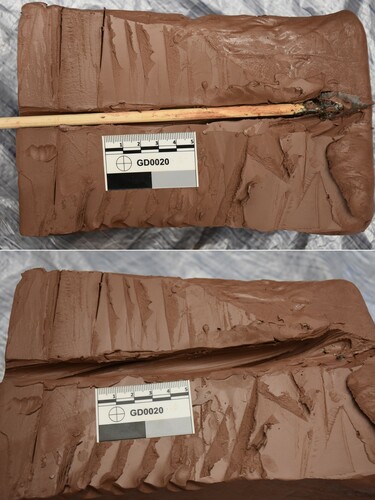
Figure 12. Radial fissures caused by lithic projectile with high cross section in gel target (projectile no. B02).
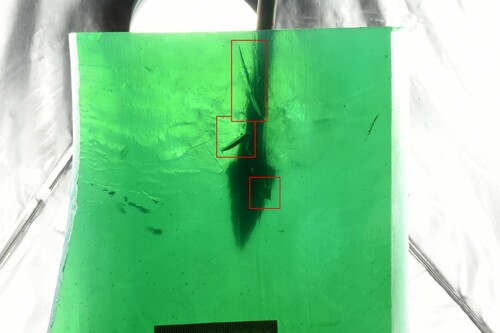
Our secondary task in the wounding experiment was to preliminarily test (two shots per overlay type, 60 shots in total) the difference in the performance and wounding capability of the projectiles on a target with an overlay designed to simulate clothes or light body defence. Because no defensive armor made of hard materials has been found in archaeological context from the studied period and territory, we tested the capability of light, lithic projectiles to penetrate light organic covers: a linen canvas, tanned leather, and gambeson. The linen canvas reduced the depth of penetration on average by 32.5% whereas soft tanned leather did so by only 26.2%. We can also say, preliminarily, that the most effective projectiles for shooting without an overlay were not the best for shooting with it (detailed information in Supplementary Information, Tables S11 and S12). The possible functional differentiation should be tested in future research. An important finding for the Early Bronze Age in the studied region was that a simple linen gambeson stuffed with sheared fleece, about 3 cm thick, prevented penetration in all cases. The key benefit of such an overlay was its flexibility rather than impenetrability because virtually all arrows penetrating through it with their tip created a slight concavity in the gel (max. depth, 2.9 cm) and bounced back. The impact of such light projectiles or arrows on a body protected by a gambeson can lead to only a shallow wound and bruising. Testing the projectile performance with an overlay, we observed small particles of overlay material introduced to the wound. Impurities were introduced for 50% of all shots at the linen canvas, and 15% of shots at the tanned goat leather (Supplementary Information Table S13) for a depth of wound of up to 10 cm. Infection was assumed to be another wounding-related factor limiting survival from such injuries (Milner, Citation2005).
In addition to their wounding capability, we tested the external ballistics of the projectiles at various distances using both archers and bows. Although the results were not statistically robust, they allowed us to define appropriate parameters of the bow, based on the need for a balance between its parameters, and those of the arrow and archer. This clarified the influence of individual archery style on performance (20 measurements of impact velocity for each ballistic type in various conditions for 200 values in total). An introduction to the rules for balancing the parameters as well as all the measured values are available in the Supplementary Information (Tables S6–S9 and Figures S9–S12). The 35-lb bow (bow X) was parametrically adequate for such light projectiles. The use of the stronger bow Y (55 lbs) represented the upper limit; in several cases, the end slot of the arrow was damaged by a split. With this bow, we also more frequently obtained atypical values of impact velocity as well as a wider ranges of values for the series of shots with the same type of ballistic specimen. Although the average impact velocities of arrows shot with the stronger bow Y were usually higher than those shot with the weaker bow X, the difference was not significant owing to the wide variation in values. With both bows, the archers were able to steadily achieve impact velocities of around 30 m/s and higher. The highest loss of velocity occurred during the first few meters during stabilization, whereas differences in the impact velocity at distances of 8, 10, and 14 m from the target were negligibly small. Despite the differences in the strength of archers and their draw lengths, skilled archers routinely adapt their performance to individual projectiles and distances to attain stable results. Such details are not deducible using machine shooting.
Discussion
The above results can be used to identify the functional purpose of projectiles from the Nitra culture in the context of other knowledge of this society. Their practical function (Kaňáková, Citation2020b; Kaňáková et al., Citation2019) and cyclic rejuvenation after the fracture of the tip (Kaňáková, Citation2020c) have been shown through use-wear analysis. In the context of practical purposes, their use against humans is supported by many facts. The specialization of individual types of projectiles for distinct ballistic effects testifies to their use against human targets, especially the design to realize a higher wounding impact in terms of the volume of the temporary wounding canal, in which the soft tissues were injured by the rotation of the projectile or perpendicular fissures. This corresponds with conclusions regarding differences in the goals of wounding as between hunting and combat with another human (Loendorf et al., Citation2015; Milner, Citation2005; Wood & Fitzhugh, Citation2018). The wide range of mobility of the archers has also been proved experimentally (Kaňáková, Citation2020b). The recorded distances of up to hundreds of kilometers do not correspond with the alimental hunting mode because game meat could not have been transported for such long distances, and osteological material attesting to wild fauna has not been found in the relevant settlements (Peška & Tajer, Citation2015; Nývltová Fišáková, Citation2007, pp. 11–13). The presence of striations in the hafting area reflects the non-glued hafting method. Flexible hafting has been reported as typical of projectiles used against humans (Loendorf et al., Citation2015, p. 944). The arrowheads were deposited in the graves of adult males (AD, MAT), and a significant number of them were accompanied by wealthy grave goods and combat injuries on the skeletons. Cenotaphic graves have also been found (Bátora, Citation2018, pp. 274–275; Hårde, Citation2006, pp. 358–360), and in other graves there were male skeletons with projectiles embedded into the bone (Bátora, Citation2018, pp. 303–304; Hårde, Citation2006, p. 365). The distribution of graves with projectiles over the territory of the Nitra culture is uneven. About 30% of graves of adult males in the northern limit of the territory belong to archers but the deposition of projectiles in graves in the central area is rare. We are restrained from using the term “warrior” and from determining that the intended function of the arrowheads was use in organized conflicts because the existence of armies or troops and battlefields has not been archaeologically proven in the studied region and period. Nevertheless, smaller, mobile, and lethal groups of archers operating in the hilly region might have played an important role in the defence of settlements or transport corridors, and guarding distribution or strategically important points in the landscape. Rich sources of copper and gold were located in the territory of the Nitra culture, and were important at that time. Activity along the Amber Road started at the same time. After the decline of the Nitra culture, a period of the massive fortification of hillforts began (Bátora, Citation2018, 263). Use of the projectiles for hunting is not supported by the findings. Bones of wild fauna in the settlements were in deep decline during the Late Eneolithic and Early Bronze Age in the eastern part of Central Europe (Bátora, Citation1991; Kyselý, Citation2012; Roblíčková, Citation2003), when the prominent peak in the presence of projectiles in the archaeological record has been documented. Only individual bones of a variety of wild animals have been found.
The essential role of archery projectiles in the processes leading to an increase in social complexity is known (Vanpool & O’Brien, Citation2013). Hunting projectiles occasionally were used in conflicts in non-stratified societies, but there was a functional split between weaponry and hunting projectiles in more complex societies (Loendorf et al., Citation2015). In Central Europe’s prehistory, archery underwent a significant change. Until our study period, projectiles were found quite sporadically and generally comprised small, short and symmetrical lithic points. At the end of the Eneolithic and in the Early Bronze Age, the number and size (i.e. the weight) significantly increased, and so did the proportion of asymmetries in the distribution of mass (Januszek, Citation2011, p. 145; Kaňáková et al., Citation2019, pp. 29–30; Kaňáková et al., Citation2020, pp. 110–111). Archery projectiles mainly occur in male grave inventories, often together with other specific grave goods, indicating that the buried individuals belonged to a special group in the population at the time (Turek, Citation2017). Society in previous periods was only horizontally-stratified (Bátora, Citation2002; Turek, Citation2004). The existence of elites and vertically-stratified societies has not been proven (Earle & Kristiansen, Citation2010). Society in the following period, the Middle Bronze Age, was already vertically stratified. There was a stratum of elite warriors, and we find richly furnished graves with specific warrior equipment as well as evidence of luxury goods (Kristiansen & Larson, Citation2005). The warrior elite were already a stable holder of power and resources, who oversaw the transport corridors and redistributed crops and natural resources (Harding, Citation2000). These social changes between late Eneolithic societies of Corded-ware or Bell beaker cultures and societies of the Middle Bronze Age seem very similar throughout Europe, although they differ slightly in chronology and manifestation (Iversen, Citation2017). The prominent peak of the lithic arrowhead’s presence sharply declined in the archaeological record of the later phases of the Early Bronze Age. Metal arrowheads were introduced later, during the Middle Bronze Age period.
Conclusions
The experiments in this study were designed to examine the ballistic qualities of lithic projectiles in Central Europe from the Early Bronze Age. Because archaeological data indicate their use against humans, we primarily assessed the wounding impact of several types of projectiles, including clarifying the wounding capability and post-contact trajectory of those with prominent cross-sectional asymmetry. The analysis of the original artefacts has shown that cross-sectional asymmetry was an intentional and desirable ballistic design (Kaňáková et al., Citation2016; Kaňáková et al., Citation2019; Kaňáková et al., Citation2020).
The ballistic types considered differed slightly in their impact velocity according to their weight and shape. The differences between different types of projectiles became more pronounced in terms of terminal ballistics. The wounding capability, expressed as the kinetic energy at the moment of impact, does not provide detailed information on the character and lethality of the wound. The effect of the hit can be better characterized by the manner in which the kinetic energy is conveyed to the body. The character of penetration then differs according to the 3D shape of projectile. Based on the results, we can divide the projectiles from the Nitra culture into four functional groups depending on the mode of loss of kinetic energy: through rotation, radial fissures, deep penetration, or contact. They can thus be functionally differentiated. Arrowheads that rotate and cause radial fissures damage the body tissues in a way that would have been counterproductive for use in hunting owing to the large volume of damaged meat. The temporary wound cavity does not represent only “temporarily displaced tissues” in the analysis of such arrowheads. Although living tissues are elastic, an arrow flying with a velocity of 30 m/s or higher causes a series of forceful tugs that do not displace but lacerate the tissues until the projectile stops. Radial fissures, i.e. cracks perpendicular to the axis of penetration, document the uneven penetration of the projectile through the target body. The slowdown caused by the resistance of the tissues and acceleration after overcoming it generates a characteristic vehement pulsation within the target body, which can be captured only with a high-speed camera. The depths of penetration and volumes of wounds due to all the tested projectiles were more than sufficient for reaching the usual depth of all major organs of the human body.
The secondary tasks of the experiment revealed that the defined ballistic types of projectiles, representing typical Early Bronze Age arrowheads of the eastern part of Central Europe, were suitable for bows with a medium draw weight of between 35 and 50 lbs. The use of a stronger bow leads to unbalanced parameters: a higher dispersion of the impact velocity and more distinct initial vibrations, sometimes even accompanied by a split in the end notch. The shooting capacity of the two archers participating in this part of the experiment was constant, and in no way affected the relevance of the results. Furthermore, although we intentionally chose archers with different capacities and draw forces, these factors did not influence the effects of the different types of projectiles. Even at a distance of 14 m from the target, all projectiles achieved an impact velocity of about 30–36 m/s. Rotationally asymmetric projectiles responded to stabilizing improvements to the arrow shaft. And while several types of projectiles achieved deep penetration and a large wound cavity volume, they were not very effective when shooting a target with an overlay. By contrast, other projectiles, which appeared to have average capability, penetrated very well through these protective layers. The ability of projectiles to inject impurities and cause infection was observed.
The absolute values of the depth of penetration and volume of the wound obtained here can be compared only with one another, and probably do not faithfully illustrate penetration into a living organism. We refer to an earlier experiment (Karger et al., Citation1998, p. 497, ), which proved that triangular projectiles penetrate fleshy (i.e. fibrous) tissues approximately 40% deeper than gel. Our results for the different types of projectiles can be used as a model for other lithic projectiles with similar shape-related attributes.
Author contribution statement
Ludmila Kaňáková – Complete text (except two paragraphs in Supplementary information text, mentioned below), experiment project and realization, all tables, Figures no. 1–2, 4–9 and S1–S4, S13.
Jana Mazáčková – consulting and realization of practical archery
Vojtěch Nosek – concept of two paragraphs in Supplementary information text, figures no. 10–12 and S5–S8, target traces measurement and documentations
Petr Huta – velocity values measurement, figures no. 3 and S9–S12.
Supplemental Material
Download MS Word (4.5 MB)Acknowledgements
We would like to express our gratitude to students Anna Nováčková, Ondrej Bobula, Jan Havelka, Lukáš Hetmánek, Ondřej Pelikán and Petr Žaža, who provided enormous help and enthusiasm to the logistics of our ballistics experiment.
Disclosure statement
No potential conflict of interest was reported by the author(s).
Additional information
Funding
Notes on contributors
Ludmila Kaňáková
Ludmila Kaňáková is archaeologist dedicated to lithic technology, life cycle and use-wear. She is applying methods of microscopy in archaeology.
Jana Mazáčková
Jana Mazáčková is archaeologist dedicated to weapons, warfare and defense in archaeologial records.
Vojtěch Nosek
Vojtěch Nosek applies 3D methods in archaeology.
Petr Huta
Petr Huta applies motion metrics.
References
- Alexandropoulou, C. A., & Panagiotopoulos, E. (2009). Traumatic ballistic: Analysis of parameters and confrontation of wounds caused from missiles in human body. Hellenic Journal of Nursing Science, 2(2), 30–34. http://journal-ene.gr/traumatic-ballistic-analysis-of-parameters-and-confrontationof-wounds-caused-from-missiles-in-human-body/?lang=en
- Anderson, D. (2010). How to make a bigger hole: An experimental analysis of projectile point morphology in wound creation. Furthering Perspectives, 4, 37–56. available https://www.scopus.com/record/display.uri?eid=2-s2.0-84940320851&origin=inward&txGid=350b2cd2dda1326ecc3b3a0366342944
- Bátora, J. (1991). The reflection of economy and social structure in the cemeteries of the Chłopice-Veselé nad the Nitra cultures. Slovenská Archeológia, 39(1–2), 91–142.
- Bátora, J. (2002). Contribution to the problem of “craftsmen” graves at the end of Aeneolithic and in the Early Bronze Age in Central, Western and Eastern Europe. Slovenská Archeológia, L-2, 179–224.
- Bátora, J. (2018). Slovensko v staršej dobe bronzovej. Comenius University in Bratislava.
- Buchanan, B., Collard, M., Hamilton, M. J., & O’Brien, M. J. (2011). Points and prey: A quantitative test of the hypothesis that prey size influences early Paleoindian projectile point form. Journal of Archaeological Science, 38(4), 852–864. https://doi.org/10.1016/j.jas.2010.11.007
- Charlin, J., & Gonzales-José, R. (2012). Size and shape variation in late Holocene projectile points of Southern Patagonia: A geometric morphometric study. American Antiquity, 77(2), 221–242. https://doi.org/10.7183/0002-7316.77.2.221
- Cheshier, J., & Kelly, R. L. (2006). Projectile point shape and durability: The effect of thickness: Length. American Antiquity, 71(Apr, 2006), 353–363. https://doi.org/10.2307/40035908
- Chochol, J. (1970). Die anthropologische analyse der auf dem schnurkeramischen Gräberfelde von Vikletice geborgenen Menschenreste. In M. Buchvaldek & D. Koutecký (Eds.), Vikletice. Ein schnurkeramisches Gräberfeld, Praehistorica III (pp. 257–283). Universita Karlova.
- Coppe, J., & Rots, V. (2017). Focus on the target. The importance of a transparent fracture terminology for understanding projectile points and projecting modes. Journal of Archaeological Science: Reports, 12, 109–123. https://doi.org/10.1016/j.jasrep.2017.01.010
- Dougherty, P. J., Najibi, S., Silverton, C., & Vaidya, R. (2009). Gunshot wounds: Epidemiology, wound ballistics and soft-tissue treatment. AAOS Instructional Course Lectures, 58, 131–139. https://pubmed.ncbi.nlm.nih.gov/19385526/
- Earle, T., & Kristiansen, K. (2010). Introduction: Theory and practice in late prehistory of Europe. In T. Earle & K. Kristiansen (Eds.), Organizing Bronze Age societies. The Mediterranean, Central Europe, & scandinavia compared (pp. 1–33). Cambridge University Press.
- Eren, M. I., Sory, B., Perrone, A., Bebber, M., Hamilton, M., Walker, R., & Buchanan B. (2020). North American clovis point form and performance: An experimental assessment of penetration depth. Lithic Technology, 45(4), 263–282. https://doi.org/10.1080/01977261.2020.1794358
- Foster, S. (2020). Beyond stone: Alternatives for atlatl dart points among the classic Maya. Texas Tech University.
- Harding, A. (2000). European societies in the Bronze Age. Cambridge University Press.
- Hårde, A. (2006). Funerary rituals and warfare in the Early Bronze Age Nitra Culture of Slovakia and Moravia. In O. Ton, H. Thrane, & H. Vandkilde (Eds.), Warfare and society: Archaeological and social anthropological perspectives (pp. 341–382). Aarhus University Press.
- Horn, P. S. (1983). Some easy t statistics. Journal of the American Statistical Association, 78, 930–936. https://doi.org/10.1080/01621459.1983.10477042
- Iversen, R. (2017). Big men and small chiefs: The creation of Bronze Age societies. Open Archaeology, 3(1), 361–375. https://doi.org/10.1515/opar-2017-0023
- Januszek, K. (2011). Krzemienne groty strzał jako przykład wyznacznika początków epoki brązu na stanowisku 1 w Suchsczu, gm. Tolkmicko, woj. Warmińsko-Mazurskie. Światowit, IX ((L)/B), 145–150.
- Kaňáková, L. (2020a). Lithic archery projectiles and their role in social dynamics and vertical stratification on the threshold of the Bronze Age. Habelt-Verlag, Studien zur Archäologie Europas 34. ISBN 978-3-7749-4271-4.
- Kaňáková, L. (2020b). Lithic arrowheads of the Nitra culture – the use of actual and experimental use-wear analyses to identify the differential effects of quiver transportation. Lithic Technology, 46, 1–13. https://doi.org/10.1080/01977261.2020.1795337
- Kaňáková, L. (2020c). Practical and symbolic aspects of the life cycle of arrowheads in Central Europe, 2400–1800 BC. In M. Bjørnevad-Ahlqvist & P. Bye-Jensen (Eds.), The life biography of artefacts and ritual practice: With case studies from Mesolithic-Early Bronze Age Europe, 71–80. BAR International series S2991. BAR Publishing, ISBN 978-1-4073-5682-2.
- Kaňáková, L., Bátora, J., & Nosek, V. (2019). Use-wear and ballistic analyses of arrowheads from the burial ground of the Nitra culture in Ludanice – Mýtna Nová Ves. Journal of Archaeological Science-Reports, 23, 25–35. https://doi.org/10.1016/j.jasrep.2018.09.028
- Kaňáková, L., Bátora, J., & Nosek, V. (2020). Use-wear and ballistic analysis of warrior arrowheads from the burial ground of Nitra Culture at Holešov – Zdražilovska, Moravia. Journal of Archaeological Science: Reports, 29, 102–126. https://doi.org/10.1016/j.jasrep.2019.102126
- Kaňáková, L., Nosek, V., & Šmerda, J. (2016). Analýza kamenných projektilů z pohřebiště starší doby bronzové Hroznová Lhota. Traseologie a balistika. Archeologické rozhledy, 68(4), 163–201.
- Karger, B., Sudhues, H., Kneubuehl, B., & Brinkmann, B. (1998). Experimental arrow wounds: Ballistics and traumatology. The Journal of Trauma, 45(3), 495–501. https://doi.org/10.1097/00005373-199809000-00011
- Kristiansen, K., & Larson, T. B. (2005). The rise of Bronze Age society: Travels, transmissions and transformations. Cambridge University Press.
- Kyselý, R. (2012). A review of archaeozoological finds from the Bell Beaker Culture in Bohemia and Moravia. In A. Matějíčková & P. Dvořák (Eds.), Funerary areas of the Bell Beaker period on the D1 Vyškov – Mořice motorway. Pravěk Supplementum 24, Volume I (pp. 431–451). ÚAPP Brno.
- Lemorini, C., & Cocca, E. (2013). Points from Gobero: Experimental and use-wear approaches. In A. A. Garcea (Ed.), Gobero: The no-return frontier. Archaeology and landscape at the Saharo-Sahelian Borderland. Journal of African Archaeology Monograph Series 9 (pp. 195–208). Africa Magna Verlag.
- Lipo, C. P., Dunnel, R. C., O’Brien, M. J., Harper, V., & Dudgeon, J. (2012). Bevelled projectile points and ballistics technology. American Antiquity, 77(4), 774–788. https://doi.org/10.7183/0002-7316.77.4.774
- Loendorf, C., Simon, L., Dybowski, D., Woodson, M. K., Plumlee, R. S., Tiedens, S., & Withrow, M. (2015). Warfare and big game hunting: Flaked-stone projectile point designs along the Middle Gila River in Arizona. Antiquity, 89(346), 940–953. https://doi.org/10.15184/aqy.2015.28
- Lombard, M. (2020). The tip cross-sectional areas of poisoned bone arrowheads from southern Africa. Journal of Archaeological Science: Reports, 33, 102477. https://doi.org/10.1016/j.jasrep.2020.102477
- Mika, A., Flood, K., Norris, J. D., Wilson, M., Key, A., Buchanan, B., Redmond, B., Pargeter, J., Bebber, M. R., & Eren, M. I. (2020). Miniaturization optimized weapon killing power during the social stress of late precontact North America (AD 600-1600). PLOS ONE, 15(3), e0230348. https://doi.org/10.1371/journal.pone.0230348
- Milner, G. R. (2005). Nineteenth-century arrow wounds and perceptions of prehistoric warfare. American Antiquity, 70(1), 144–156. https://doi.org/10.2307/40035273
- Nosek, V., & Kaňáková, L. (2021). Analytical potential of 3D data in the ballistic analyses of lithic projectiles. Journal of Archaeological Science: Reports, 38, 1–7. https://doi.org/10.1016/j.jasrep.2021.103042
- Nývltová Fišáková, M. (2007). Zpráva o analýze zvířecího osteologického materiálu Hulín I. Attachment of unpublished excavation report Archeologické centrum Olomouc.
- Peška, J., & Tajer, A. (2015). Problematika epišňůrových sídlišť na Moravě – stav poznání. In J. Bátora & P. Tóth (Eds.), Keď bronz vystriedal meď. Zborník príspevkov z XXII. medzinárodného sympózia “Staršia doba bronzová v čechách, na Morave a na Slovensku”, Levice 8-11. októbra 2013 (pp. 77–104). Nitra.
- Pettigrew, D. B., Whittaker, J. C., Garnett, J., & Hashman, P. (2015). How atlatl darts behave: Beveled points and the relevance of controlled experiments. American Antiquity, 80(3), 590–601. https://doi.org/10.7183/0002-7316.80.3.590
- Roblíčková, M. (2003). Domesticated animal husbandry in the Bronze Age on the basis of osteological remains. Archeologické rozhledy, 55(3), 458–499.
- Salem, P. E., & Churchill, S. E. (2016). Penetration, tissue damage and lethality of wood- versus lithic-tipped projectiles. In R. Ioviota & K. Sano (Eds.), Multidisciplinary approaches to the study of stone age weaponry. Vertebrate paleobiology and paleoanthropology series (pp. 203–212). Springer Science + Bussiness Media Dordrecht.
- Schyma, C. (2010). Color contrast in ballistic gelatine. Forensic Science International, 197(1–3), 114–118. https://doi.org/10.1016/j.forsciint.2010.01.002
- Schyma, C. (2020). Ballistic gelatine–what we see and what we get. International Journal of Legal Medicine, 134(1), 309–315. https://doi.org/10.1007/s00414-019-02177-z
- Sitton, J., Story, B., Buchanan, B., & Eren, M. I. (2020). Tip cross-sectional geometry predicts the penetration depth of stone-tipped projectiles. Scientific Reports, 10(10), 13289. https://doi.org/10.1038/s41598-020-70264-y
- Stloukal, M. (1985). Antropologický rozbor koster z pohřebiště v Holešově. Studie Muzea Kroměřížska, 85, 131–169.
- Šefčáková, A. (2014). Antropologická analýza pohrebiska nitrianskej kultury ze Zohora, okr. Malacky. Slovenská archeológia, 62(2), 293–314.
- Titmus, G. L., & Woods, J. C. (1986). An experimental study of projectile point fracture patterns. Journal of California and Great Basin Anthropology, 8, 37–49.
- Tomasso, A., Rots, V., Purdue, L., Beyries, S., Buckley, M., Cheval, C., Cnuts, D., Coppe, J., Julien, M. A., Grenet, M., Lepers, C., M'hamdi, M., Simon, P., Sorin, S., & Porraz, G. (2018). Gravettian weaponry: 23,500-year-old evidence of a composite barbed point from Les Prés de Laure (France). Journal of Archaeological Science, 100, 158–175. https://doi.org/10.1016/j.jas.2018.05.003
- Turek, J. (2004). Craft symbolism in the Bell Beaker burial customs. Resources, production and social structure at the end of Eneolithic period. In M. Besse & J. Desideri (Eds.), Graves and Funerary Rituals during the Late Neolithic and the Early Bronze Age in Europe (2700-2000 BC) Proceedings of the International Conference held at the Cantonal Archaeological Museum, Sion (Switzerland) October 4–7, 2001. BAR International Series 1284 (pp. 147–156). Archaeopress.
- Turek, J. (2017). Prehistoric ceremonial warfare: Beginning of institutionalized violence. Archaeologies: Journal of the World Archaeological Congress. https://doi.org/10.1007/s11759-017-9330-x.
- Vanpool, T. L., & O’Brien, M. J. (2013). Sociopolitical complexity and the bow and arrow in the American Southwest. Evolutionary Anthropology, 22(3), 111–117. https://doi.org/10.1002/evan.21355
- Waguespack, N., Surovell, T. A., Denoyer, A., Dallow, A., Savage, A., Hyneman, J., & Tapster, D. (2009). Making a point: Wood- versus stone-tipped projectiles. Antiquity, 83(321), 786–800. https://doi.org/10.1017/S0003598X00098999
- Wilkins, J., Schoville, B. J., & Brown, K. S. (2014). An experimental investigation of the functional hypothesis and evolutionary advantage of stone-tipped spears. PLOS ONE, 9(8), 1–13. https://doi.org/10.1371/journal.pone.0104514
- Wood, J., & Fitzhugh, B. (2018). Wound ballistics: The prey specific implications of penetrating trauma injuries from osseous, flaked stone, and composite inset microblade projectiles during the Pleistocene/Holocene transition Alaska U.S.A. Journal of Archaeological Science, 91, 104–117. https://doi.org/10.1016/j.jas.2017.10.006
- Yaroshevich, A., Kaufman, D., Nuzhnyy, D., Bar-Yosef, O., Weinstein-Evron, M. (2010). Design and performance of microlith implemented projectiles during the Middle and the late epipaleolithic of the levant: Experimental and archaeological evidence. Journal of Archaeological Science, 37(2), 368–388. https://doi.org/10.1016/j.jas.2009.09.050

